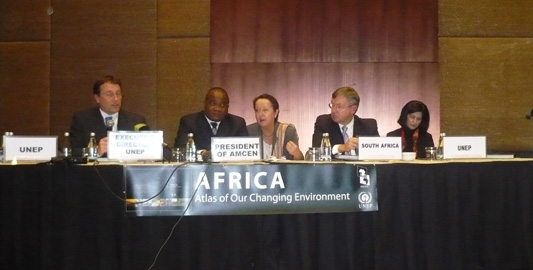Atlas charts Africa climate change
A new publication details environmental challenges facing the continent.

 |
| UNEP Achim Steiner, Congo environment minister Andre Okombi Salissa, and Marthius Van Schawkwyk, the South Africa minister on environment and tourism, unveil the atlas |
The Atlas for Changing Environment in Africa, a 400-page publication that underlines how development choices, population growth, climate change and conflict impact natural-based assets was officially launched at the Sandston Convection Centre in Johannesburg, South Africa on June 10.
The Atlas compiled by the United Nations Environment Programme (Unep) features over 300 satellites images of over 100 locations taken in every African nation. The before-and-after photographs offer striking snapshots of environmental transformation across the continent.
Aloysius Kamperewera, Malawi’s representative at the conference and acting director of environment, said each country was asked to chart physical changes over a 35-year period to a particular geographic and compare the changes that have occurred as a result of human development in that area.
The Unep atlas depicts changes on Kenya’s Mount Kilimanjaro’s shrinking glaciers, the drying up of Lake Chad and failing waters in the Lake Victoria,region, among others. It also presents for the first time satellite images of new or lesser known environmental changes and challenges in Africa.
The atlas was launched during the 12th session of the African Ministerial Conference on Environment (Amcen).
Andre Okombi Salissa, current Amcen president who also doubles as minister of Tourism and Environment in the Democratic Republic of Congo said that the group has been working with major collaborating partners that include multilateral and civil society groups like the African Union and the New Partnership for African Development (Nepad).
Catalyst for change
 |
| Environmentalists will publish the atlas online where they hope it will appeal to youth [GETTY] |
Salissa told Al Jazeera that the Atlas well help to give policy makers focus on how to tackle Africa’s immediate environment challenges.
“It will be a catalyst to remedy areas where the environment has been degraded as pictures speaks volumes of the impact of pollution, environmental deforestation and biodiversity threat among others,” he said.
Achim Steiner, the Unep executive director told Al Jazeera that the UN is hoping to reach out to students and youth by making use of web and online services.
“We have made substantial investment on internet based information. This should be accessed by students, the large citizenry and non-governmental organisations. The atlas will be going live on the web today for other users to access it. We will later put it on Google Earth to benefit millions worldwide,” Steiner said.
Environment ministers are hoping that the before-and-after imagery will raise immediate awareness of the environmental obstacles facing development in Africa.
“It forces you to take action. There are pictures that go way back depicting how Africa was then and the same areas how it is today,” Rachael Musoke, commissioner at the ministry of water and environment in Uganda, told Al Jazeera.